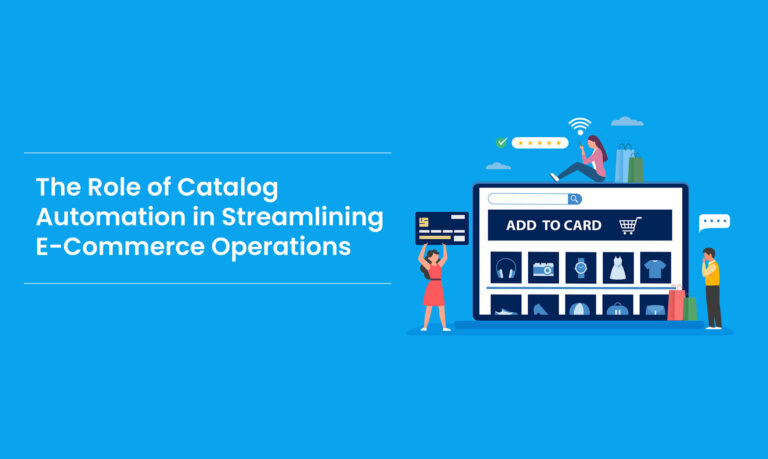Introduction
Your customers always expect a seamless and engaging online shopping journey, whether exploring your brand website’s catalog, browsing your Amazon store, or visiting your retail outlet.
First and foremost, customers expect swift access to the products they’re searching for.
Once they find them, they do product research, browse through images and videos, read product descriptions, read reviews, and compare attributes like colors, fabrics, and materials.
These elements collectively form a comprehensive product experience that customers consider essential.
In today’s fiercely competitive market, getting the e-commerce experience right is crucial—85% of customers emphasize the significance of a company’s experience alongside its products or services.
However, achieving a stellar e-commerce experience can be challenging, especially for busy e-commerce stores handling large product volumes. According to a survey, 44% of brands cite controlling the customer experience as a major challenge in marketplace selling.
Fortunately, leveraging AI for catalog management is a breakthrough for e-commerce businesses. Read this article to learn the transformative impact of AI on catalog automation and how it allows businesses to deliver seamless and engaging online shopping experiences.
What Is Product Catalog Management?
Product catalog management is an internal procedure that organizes and ensures product data is current and correct.
The objective is to create a uniform system across all sales channels that allows you to filter, retrieve, and modify your catalog based on parameters like product title, description, pricing, SKUs, and suppliers, even if there is a lot of variation across goods or categories.
It is especially critical for major e-commerce stores with different vendors or multi-seller marketplaces, as input product data can differ significantly from seller to seller, causing challenges when standardizing internally.
What Is Product Catalog Optimization?
Product catalog optimization is an essential information activity that enhances potential consumers’ shopping experiences to increase conversion rates and buyer trust. When you’ve piqued the curiosity of potential buyers, you must capitalize on it because 79% of your visitors will go to a competitor’s site for the same goods if they can’t find what they’re searching for.
Product catalog optimization advantages are more than on-site conversions and prospective client trust. Optimizing your catalog can increase organic traffic by improving search engine optimization (SEO) results. Only 0.78% of Google searchers click on a result from the second page, whereas the top-ranked page receives 49% of all search traffic.
Challenges of Organizing Product Catalogs
The challenge of organizing product catalogs using traditional methods is nothing short of Herculean. It involves manual data entry, sifting through extensive product information, and ensuring catalog details are updated.
The high likelihood of human error, time consumption, and operational costs presents a significant obstacle.
Manual Data Entry
One of the primary challenges lies in accurately entering and updating product details. As the array of products grows, this becomes a substantial workload.
From pricing to product specifications, a large volume of data must be manually input, which can quickly become an overwhelming task.
Sorting Through Product Information
It entails categorizing products into relevant groups, interpreting product descriptions, and organizing them in a user-friendly manner.
However, as the catalog size increases, categorization becomes more complex. It can become a confusing product data maze, making it challenging for catalog managers.
Maintaining Catalog Details
Ensuring real-time accuracy is crucial in an environment where product information, prices, and availability fluctuate constantly.
However, manual updating is highly time-consuming and increases the risk of errors.
High Risk of Human Error
Despite the team’s diligence, there is always a risk of incorrect data entry, misclassification, or overlooked updates. These errors can negatively impact consumer purchasing decisions and harm the company’s reputation.
Operational Costs
The costs associated with manually scaling product catalogs can become a financial strain. Hiring additional staff, investing in training, and managing the workforce can quickly accumulate and affect profitability.
How Is AI Transforming Catalog Automation?
Let’s explore some areas where AI is transforming catalog automation:
AI-Enhanced Analytics
The utilization of AI in catalog management brings forth significant advantages, particularly in harnessing analytics. By aggregating data from diverse e-commerce sources, businesses gain valuable insights into customer behaviors, trends, and preferences. AI algorithms analyze this data with greater efficiency to improve business decisions and personalized experiences. The incorporation of AI-driven analytics assists businesses in anticipating consumer needs and refining their catalogs accordingly, resulting in heightened sales and customer satisfaction.
Empowering Product Catalogs
Maintaining the latest and most appealing product catalog is critical for e-commerce prosperity. AI empowers businesses to spot new products, monitor evolving trends, and eliminate redundancies. By integrating AI into catalog management processes, companies ensure that product details like technical specifications, images, availability, and descriptions are precise and enticing. Moreover, AI-driven machine learning algorithms categorize products, simplifying the provision of relevant recommendations to shoppers.
Minimizing Errors and Enhancing Precision
Human errors in catalog management can be financially burdensome for businesses. AI offers a solution by identifying discrepancies in product listings, inaccuracies in descriptions, and other catalog discrepancies. By automating data management, AI contributes to maintaining accurate and error-free catalogs, saving time, and enhancing customer experiences. AI and machine learning refine catalog processes for data enrichment, adherence to standards, and improved customer interactions. Rather than displacing human intelligence, AI complements it by handling data security and allowing human employees to focus on higher-level tasks.
Improving Search Outcomes
AI, through Natural Language Processing (NLP) algorithms, enhances the search experience for e-commerce entities. NLP empowers search engines to comprehend user intent better and furnish more pertinent product suggestions. By considering past search results and context, AI-driven search algorithms refine and elevate search outcomes. NLP also facilitates data extraction from unstructured sources like images, videos, and audio, enhancing customer satisfaction and boosting conversions.
Enhancing Product Discoverability and SEO
Having detailed and high-quality product information is vital for enhancing discoverability and search engine rankings. AI-infused catalog management systems ensure product data is updated and optimized for improved visibility on search engines and marketplaces. By integrating AI into product management, businesses bolster organic traffic, brand visibility, and overall e-commerce expansion. AI-driven data catalogs offer swift access to relevant products, enriching customers’ browsing experience.
Augmenting Customer Experience
AI contributes to enhancing the customer experience in catalog management. Leveraging AI technologies such as natural language processing (NLP) and machine learning, e-commerce enterprises provide personalized product recommendations, tailored search results, and customized shopping experiences. AI algorithms analyze customer data to comprehend preferences offer relevant products, foster satisfaction, and increase conversion rates.
Efficient Inventory Management
Effective catalog management necessitates accurate and real-time inventory management. AI-powered systems automate inventory tracking and management processes for precise product information, availability, and stock levels across channels. With instantaneous inventory visibility, businesses can avoid overselling, improve order fulfillment, and optimize supply chain operations. AI algorithms analyze sales data, demand patterns, and market trends to provide intelligent inventory forecasting.
Enhanced Data Governance and Compliance
Data governance and compliance are critical aspects of catalog management, especially regarding data privacy and security. AI-driven catalog management systems enforce data governance policies, automatically identify sensitive data, apply access controls, monitor data usage, and generate audit trails for compliance. It ensures data protection and regulatory compliance and mitigates the risk of data breaches.
Scalability and Adaptability
AI-powered catalog management technologies are scalable, versatile, and capable of handling massive volumes of data, enabling organizations to respond to market changes. As e-commerce businesses build their product libraries, AI effectively processes and analyzes volumes of data, assuring accuracy and relevance in catalog updates, product suggestions, and search results. AI systems respond to shifting tastes, trends, and tactics, constantly refining catalog management operations and providing a consistent user experience.
Case Studies: AI Success Stories in Catalog Automation
Several e-commerce giants have successfully leveraged AI to revolutionize their catalog management and enhance customer experiences. Let’s look at some notable case studies:
- Amazon’s recommendation engine, powered by AI, analyzes customer behavior and purchase history to suggest relevant products. The personalized approach has contributed to Amazon’s success in driving sales and customer engagement.
- Alibaba uses AI-driven image recognition technology to improve its platform’s visual search capabilities. It allows users to search for products using images captured from their devices, leading to a more intuitive shopping experience.
- Walmart employs AI for dynamic pricing and personalized promotions to optimize pricing strategies based on market trends and customer insights. The pricing approach has helped Walmart stay competitive and drive customer loyalty.
Conclusion
Customers expect to discover thorough, accurate, and on-brand product information via your website, catalogs, emails, social media, advertisements, and other sources, as well as from third-party marketplaces. Engaging visuals, informative descriptions, and accurate inventory promote purchases and customer satisfaction. Boost team productivity by automating catalog management chores to lessen errors, save time and aggravation, accelerate time to market, and enhance the customer experience.
Accelerate your catalog management with Rubick.ai. Take a demo today for faster categorization, streamlined management, and superior data quality.


